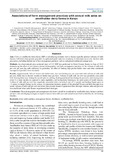Associations of farm management practices with annual milk sales on smallholder dairy farms in Kenya

Date
2015Author
Shauna, Richards
VanLeeuwen, John
Shepelo, Getrude
Gitau, George Karuoya
Kamunde, Collins
Uehlinger, Fabienne
Wichtel, Jeff
Language
enMetadata
Show full item recordAbstract
Aim:
Cows on smallholder dairy farms (SDF) in developing countries such as Kenya typically produce volumes of milk
that are well below their genetic potential. An epidemiological study was conducted to determine reasons for this low milk
production, including limited use of best management practices, such as suboptimal nutritional management.
Methods:
An observational cross-sectional study of 111 SDF was performed in Nyeri County, Kenya in June of 2013
determining the effect of cow factors, farmer demographics and farm management practices on the volume of milk sold
per cow per year (kg milk sold/cow). In particular, the effect of feeding high protein fodder trees and other nutritional
management practices were examined.
Results:
Approximat
e
ly 38% of farmers fed fodder trees, but such feeding was not associated with volume of milk sold
per
cow, likely due to the low number of fodder trees per farm. Volume of milk sold per cow was positively associated
with
feeding dairy meal during the month prior to calving, feeding purchased hay during the past year, deworming cows
every 4
or more months (as opposed to more regularly), and having dairy farming as the main source of family income.
Volume of
milk sold per cow was negatively associated with a household size of >5 people and feeding Napier grass at
>2 meters in
height during the dry season. An interaction between gender of the principal farmer and feed shortages was
noted; volume
of milk sold per cow was lower when female farmers experienced feed shortages whereas milk sold per cow
was unaffected
when male farmers experienced feed shortages.
Conclusions:
These demographic and management risk factors should be considered by smallholder dairy farmers and their
advisers when developing strategies to improve income from milk sales and animal-source food availability for the farming
families.
Keywords:
dairy cattle nutrition, management factors, livelihood, smallholder farm
Publisher
University of Nairobi
